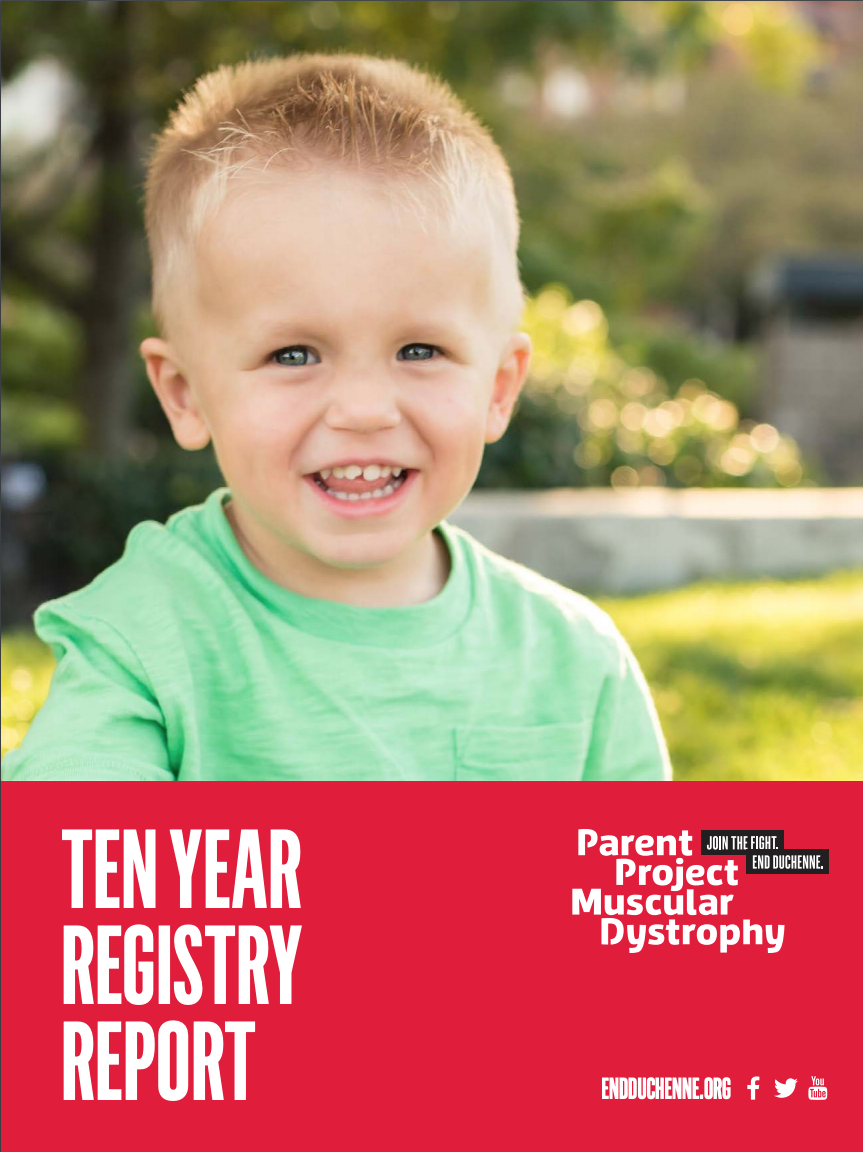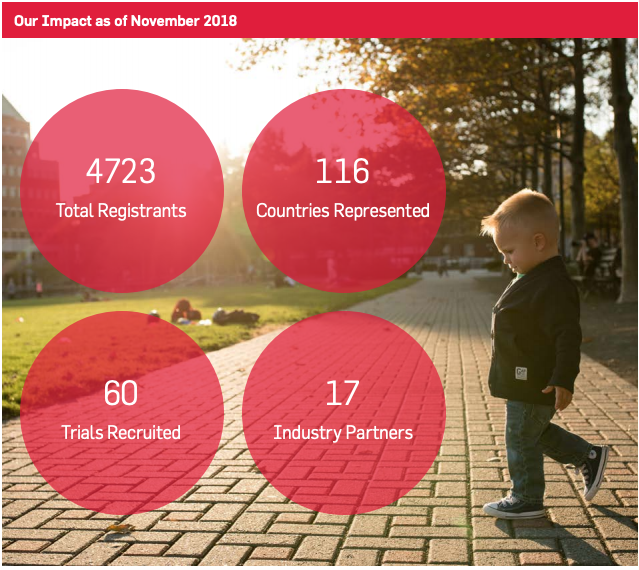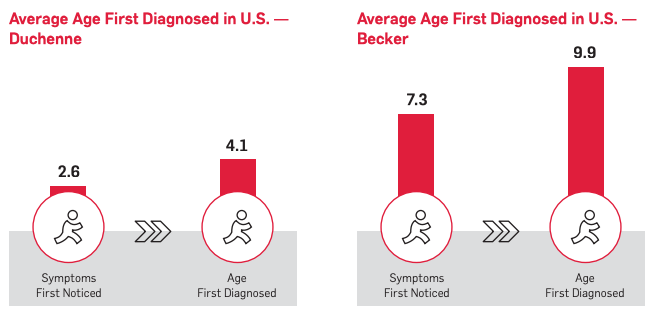
PPMD is excited to announce the release of the Ten Year Registry Report. This report is the culmination of data provided by registrants in The Duchenne Registry, as well as collaborative work with expert clinicians and researchers over the past ten years. The Duchenne Registry is the largest, most comprehensive patient-reported registry for Duchenne and Becker muscular dystrophy.
Ann Martin, a certified genetic counselor and Director of The Duchenne Registry, explains the process the organization went through to compile this report: “At the end of 2017, when the Registry reached its ten year anniversary, we exported all data from the Registry. The multiple data exports were de-identified and provided to a team of analysts at RTI International Center for Newborn Screening, Ethics, and Disability Studies. This team cleaned the data, ran statistical analyses, and provided PPMD with all charts and graphs used in the report. The PPMD Registry team reviewed all analyses, determining which were most relevant to our community. With the volume of data collected over ten years, there remains additional analyses that PPMD is currently exploring.”
Ann adds, “Because families continue to join and update their account in The Duchenne Registry, they are strengthening the power of this 10-year network of patient-powered data that will be used to improve care for people living with Duchenne and increase understanding of the disorder. Families have become citizen scientists by contributing to real scientific research, without ever leaving their homes.”
Download the ReportUse of Data
The de-identified data in The Duchenne Registry has been used by researchers and sponsors to advance care and treatments for individuals with Duchenne. Over the past ten years, data has been exported and shared with researchers nearly 50 times, including multiple exports to the TREAT-NMD International Neuromuscular Registry. To date, eight publications have used data from The Duchenne Registry, and two additional publications are currently in press. Numerous posters and presentations at scientific meetings have referenced the Registry data. Visit our website to learn more about our publications.
In the past ten years, the Registry team has used the data to identify and connect individuals with Duchenne and Becker to over 60 actively recruiting clinical trials and even more non-interventional research studies. In addition, data from the Registry has been utilized by PPMD to identify community needs and priorities.
Download the ReportThe data collected and compiled by this Registry belongs to The Duchenne Registry community. PPMD is the guardian of the information contained within the Registry. Only PPMD staff who are part of the core Registry team have access to the secure database that contains the personal medical information.
A Look at the Results
The Ten Year Registry Report is a summary of approximately 4000 registrants representing over 100 countries. To participate, a registrant must have a diagnosis of Duchenne or Becker muscular dystrophy. Participants in the Registry at the time the report was compiled include: 76% with Duchenne, 7% with Becker, 7% with Duchenne or Becker (diagnosis unclear), and 10% female carriers.
Analyses revealed that the average age at diagnosis in the U.S. is four-years-old for Duchenne and ten-years-old for Becker. The average age when symptoms were first noticed was two and half years for Duchenne and seven years for Becker.
Download the ReportThe 32-page report reveals a number of interesting data points PPMD believes will be important to researchers and industry partners focused on the development of Duchenne therapies. Some of those findings include:
- The three most common categories of genetic mutations in registrants are whole exon deletions (65%), nonsense mutations (13%), and whole exon duplications (10%).
- The majority of registrants are currently using or have used corticosteroids, but 35% report never using corticosteroids.
- For those registrants who have never used corticosteroids, their average age at loss of ambulation was 10 years old. Ambulation is prolonged, on average, by one year with prednisone use and two years with deflazacort use.
- When comparing the years 2007-2012 versus 2013-2017, corticosteroid use became more prevalent in older, non-ambulatory males with Duchenne.
- The use of breathing devices and echocardiogram in Duchenne also increased across most age groups, when comparing the time periods 2007-2012 and 2013-2017, with some age groups having statistical significance. More consistent use of corticosteroids in the older age groups, as well as more consistent use of breathing devices and echocardiogram, may be a reflection of better adherence to the standard of care guidelines, first published in 2010.
What’s Next for The Duchenne Registry?
PPMD recently announced a partnership with THREAD, a company specializing in remote/virtual patient research, to enhance the patient engagement and care management tools for the Registry.
Updates to the Registry platform are aimed at making it easier to navigate, more engaging for patients and families, and more convenient to access. The new interface will launch in Q1 2019 and will be primarily mobile app based (useable on both iOS and Android), with a web portal to help patients determine registry eligibility. Through the Registry app, patients and families will still have robust access to PPMD’s valuable patient education resources and news.
The History of the Registry
The Duchenne Registry (formerly DuchenneConnect) began in 2007, when a group of thought leaders in the Duchenne and Becker muscular dystrophy community began discussing the need for a new kind of resource that would connect and serve the needs of the entire community. What they envisioned was a central hub that would bring together those living with Duchenne or Becker, along with their families and caregivers, to connect them with medical research, clinical care, clinical trials, and each other. At the same time, it would also be a resource for researchers and industries with an interest in Duchenne, allowing access to aggregate, de-identified data provided by patients and their families — information that could prove vital to advances in care and treatment. Today, the result of this endeavor is The Duchenne Registry, the largest, most comprehensive registry for Duchenne and Becker muscular dystrophy and female carriers.
Since 2011, The Duchenne Registry has been funded entirely by PPMD, and PPMD is the sole guardian of the Registry and its material. PPMD is deeply committed to the Registry to ensure that it is serving the needs of the entire Duchenne and Becker community.
To learn more about The Duchenne Registry, visit DuchenneRegistry.org.
Download the Report


 by: Parent Project Muscular Dystrophy
by: Parent Project Muscular Dystrophy



